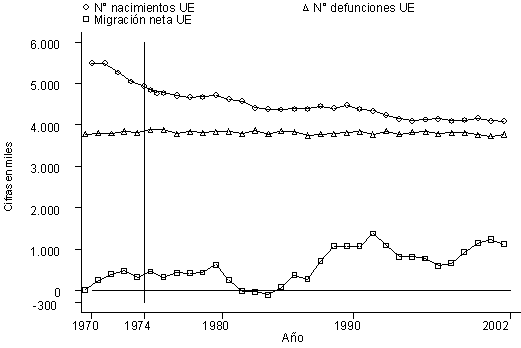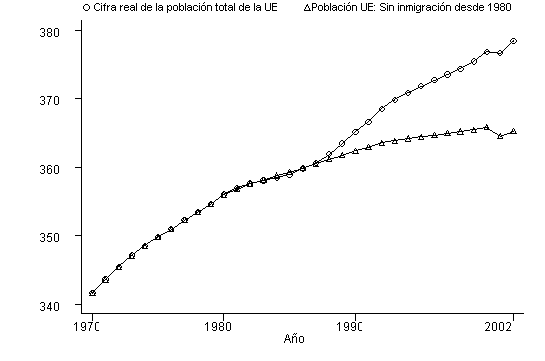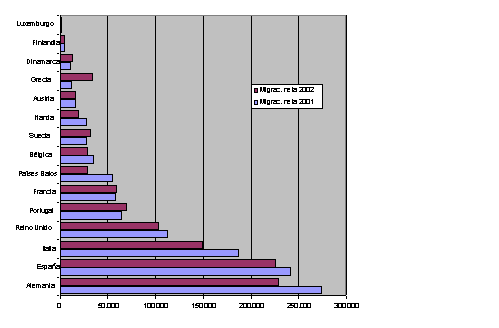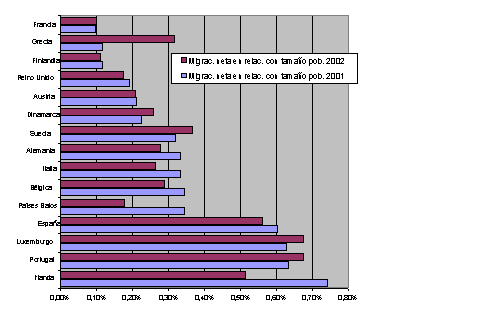Subject: Europe’s demographic landscape is in constant change. The present analysis takes stock of the latest comparative data for the European Union, released in January 2003. It assesses the main demographic and migratory trends in Europe, and concludes by discussing population policy areas of central importance for Spain.
Summary: The European Union’s population is growing. However, in analyzing the underlying causes for this growth, it is evident that international migration rather than natural increase is of paramount importance for sustained population growth in Europe. In the concluding discussion of this analysis, I deal with the demographic developments and the future role of immigration from the perspective of the European common market. The analysis shows consistently that immigration is a key factor in preventing a situation of potential population decline and labor shortages that may offset the European markets global competitiveness. The data on current immigration support the notion that Spain is Europe’s most important country in terms of immigration, and that it should take a leading role in shaping Europe’s future immigration policies.
Analysis: The analysis focuses on the following main demographic indicators: 1) Population Size and Increase 2) Births and Deaths and 3) International Migration.
Population Size
The first of January 2002 the European Union’s population was approximately 377.1 million people, which is an increase by 1.5 million (0,4%) people compared to 2001. Estimates for 2002 suggest a continued modest increase (0,36%), and if these estimates are confirmed the European Union’s total population is now somewhere in the region of 378.4 million people.
If we exclude countries outside the euro zone, i.e., the UK, Denmark, and Sweden, the number of people using the euro as their primary currency was 303.9 million at the beginning of 2002. The speed of the euro zone’s population growth rate was 0.42%. Estimates indicate that the euro zone’s population grew with a rate of 0.37% in 2002 and that it reached 305 million by January 2003. This can be compared with the US, whose population stands at 290.1 million people and is growing by 1.1%.
At the start of 2001, 79% or 297.4 million of EU’s population live in Germany, France, Italy, Spain, and the UK. Although Spain is substantially smaller than the other four countries, it has the group’s fastest population increase (0.72%). Spain’s growth rate also stands out when compared to the Union as a whole. Spain ranked fourth in growth in 2001, surpassed only by Ireland, Luxembourg, and the Netherlands in 2001(see table below).
Table 1 Population change in the European Union 2001-2003
|
Country |
Population Jan 1 2002 |
Population Jan 1 2001 |
Increase |
Increase (%) 2001-2002 |
Estimated Population Jan 1 2003 |
Estimated Increase (%) 2002-2003 |
|
Germany |
82.440.300 |
82.259.540 |
180.760 |
0.22 |
82.555.300 |
0.14 |
|
France |
59.344.025 |
59.038.459 |
305.566 |
0.52 |
59.639.325 |
0.50 |
|
UK |
58.928.857 |
58.745.286 |
183.571 |
0.31 |
59.088.180 |
0.27 |
|
Italy |
56.331.900 |
56.167.111 |
164.789 |
0.29 |
56.463.900 |
0.23 |
|
Spain* |
40.409.330 |
40.121.673 |
287.657 |
0.72 |
40.683.300 |
0.68 |
|
Netherlands |
16.105.285 |
15.987.075 |
118.210 |
0.74 |
16.194.900 |
0.56 |
|
Greece |
10.988.000 |
10.955.000 |
33.000 |
0,30 |
11.018.400 |
0.28 |
|
Portugal |
10.335.559 |
10.262.877 |
72.682 |
0.71 |
10.408.500 |
0.71 |
|
Belgium |
10.309.725 |
10.263.414 |
46.311 |
0.45 |
10.346.200 |
0.35 |
|
Sweden |
8.909.128 |
8.882.792 |
26.336 |
0.30 |
8.942.500 |
0.37 |
|
Austria |
8.139.310 |
8.121.345 |
17.965 |
0.22 |
8.159.300 |
0.25 |
|
Denmark |
5.368.354 |
5.349.212 |
19.142 |
0.36 |
5.387.600 |
0.36 |
|
Finland |
5.194.901 |
5.181.115 |
13.786 |
0.27 |
5.207.300 |
0.24 |
|
Ireland |
3.882.683 |
3.826.159 |
56.524 |
1.48 |
3.930.500 |
1.23 |
|
Luxembourg |
444.050 |
439.539 |
4.511 |
1.03 |
448.600 |
1.02 |
|
Total |
377.131.407 |
375.600.597 |
1.530.810 |
0,41 |
378.473.805 |
0,36 |
|
Source: EUROSTAT and the Council of Europe * For comparative reasons, data for Spain refer to the information provided by INE during 2002 to the two sources mentioned above. This data is in accordance with the Spanish Census in 2001 and not the municipal registers. ** The 2001 figures for Greece and Italy are pending revision following the results from the census round in 2001. |
||||||
The Union’s growth rate in 2001 is not very impressive, however, and the estimates for 2002 indicate a further slowdown signaling an imminent risk for population decline in the Union as a whole. Germany and Italy are already experiencing substantial natural population decrease and only grow with the help of their positive net migration. The inverted relationship between population size and the rate of growth inside the Union is also worrisome. This relationship undermines the capacity for strong-growth countries to compensate for the absolute effects of population decline in the likely event of negative growth in some of the bigger countries such as Germany, Italy, and the UK. For example, it only takes a modest decrease of 0,08% of Germany’s population to wipe out the combined absolute growth contributed by Ireland and Luxemburg.
The risk of declining population is likely to continue, or even become accentuated, after the enlargement. The Union will experience a one-time population injection of approximately 74 million people when the 10 accession countries become members. However, of the 10 countries, only Cyprus, Malta, and Slovenia, with a combined total population lower than Ireland’s, show growth today. The population in the remaining seven, including Poland, is declining, and the ten together decreases by about 0.2% annually.
Births and Deaths
The perhaps most dramatic trend in Europe is the impressive increase in life expectancy that has taken place in the course of just a few generations. For example, in 1960 life expectancy at birth in the EU was 70.15 years compared to 78.35 in 2000 –an increase of more than eight years in just forty years. The macro effect of this phenomenon is a lower risk of dying. When the risk of dying decreases, there are fewer deaths in the population relative to population size, and the potential for population growth is very good.
However, another prerequisite for growth is the occurrence of births. At the same time as the Union has experienced rapidly improving mortality rates, it has also seen a spectacular drop in fertility. The Union’s fertility rate dropped below the replacement level (2.1 children per woman) in the mid 1970. After hitting a bottom of 1.42 in 1995, it reached 1.47 in 2001. The decreasing number of births has caused the Union’s population to grow slower than would otherwise have been, due to the rapidly improving mortality rates occurring in parallel.
Figure 1. Components of Population Growth, Births, Deaths, and Migration

Figure 1 shows the development in total number of births and deaths between 1970 and 2003 in the European Union. The interpretation of the development is straightforward. The Union’s falling fertility rate is producing decreasing birth totals, and the decreasing risk of dying occurring in parallel result in a more or less constant number of deaths, despite a simultaneous population increase in the same period.
Persistent total fertility rates below the replacement level will inevitably result in a shift where the number of deaths outnumbers the births. The Union has been close to this shift since the mid-nineties, but it is first now that the Union is starting to experience the long-term effect of its below replacement fertility, like for example maintaining current birth rates with fewer potential mothers around.
Looking at the numbers, in 2000 births exceeded deaths by 390 thousand, in 2001, the difference was 360 thousand, and estimates for 2002 indicate a difference of 315 thousand. The trend is evident: zero growth should occur 6-7 years from now if the decrease is constant. However, if we analyze the development in births and deaths at the country level a constant decrease seem unlikely.
In 2000, twelve of the fifteen EU members registered increased number of births, and only one country registered an increase in the number of deaths. In 2001, ten countries experienced falling number of births, and only two saw an increase in the number of deaths. Eurostat’s estimates for 2002 indicate that ten countries experienced falling number of births and that all countries except Luxembourg experienced an increase in the number of deaths. In other words, over the last three years the relationship between births and deaths has turned from a situation favorable to growth in 2000, to a mixed situation in 2001, and finally to a situation unfavorable to growth in 2002. This could be an indication that the Union may just have past a threshold, leading straight on to a natural population decrease much sooner than indicated above.
Spain’s development regarding births and deaths is somewhat atypical compared to the development in other EU countries. Spain has one of the Union’s highest recorded increases in the total number of births in 2000 and 2001, and estimates for 2002 place Spain in first place in terms of increased number of births. Looking at the period 2000-2002, Spain is the only country in the Union with higher natural increase in three consecutive years. The increasing number of births is one explanation of why Spain has one of Union’s fastest growing populations in both relative and absolute terms (see table above). However, and as we will see in the next section, Spain’s positive development with respect to fertility in recent years is conditioned on its rapidly increasing immigrant population rather than its native population.
International Migration
The only reason why the Union’s population is still growing significantly is immigration. Of the total population increase of 1.5 million in 2001, 360 thousand is due to natural increase and 1.14 million is due to immigration. (Figure 1 depicts the variation in the Union’s net-migration from 1970.)
The importance of immigration for sustained population growth is no new phenomenon in Europe, however. One way to assess its importance visually is by simulating the size of the Union’s population without the cumulative impact of immigration. Figure 2, shows a “closed border” scenario where the net migration into the Union is set to zero starting from 1980 and compares it with the real population development for the same period.
Figure 2. Immigration into European Union – EU’s population with or without immigration

Comparing the simulated population development with the real population development indicates that without immigration in the eighties and nineties, the Union’s population growth approaches zero. Immigration is responsible for 60% of the Union’s population growth for this period. Eurostat, in looking only on the nineties, has estimated that immigration is responsible for as much as 80% of the population growth in this shorter period.
It is worth noticing that growth in the scenario excluding migrants is exaggerated. The reason for this is that I have not corrected for the known positive effects of immigration on birth and mortality rates when calculating the closed border scenario. For example, in the case of Spain, while the total number of births in Spain increased in 2001, Spanish-born mothers conceived fewer children than in 2000. Thus, in Spain, immigrant mothers are not only responsible for the total increase in births, but they are also compensating for the native populations falling fertility (Instituto Nacional de Estadística, 2002). This, in combination with a very high level of immigration into Spain, is the primary reason why Spain is doing so well compared to other countries in terms of the vital rates discussed in the section above.
The characteristic of immigrants is an important factor when discussing population growth. New arrivals are usually young people under 30. Thus, they have a direct positive effect on the development of the usually declining working age population in the receiving country. Moreover, and as illustrated by the Spanish example, being predominantly young people, they are potential parents, which is positive for the receiving country’s birth rate.
Despite the importance of immigration for sustained population growth, many member states have voiced concerns about immigration. When assessing the member states policy on immigration levels, eight countries report that their policy aims at lowering the current levels, and seven to maintain current levels. When asked about the current immigration level, seven countries said it is too high, and nine that it is satisfactory (UN National Population Policies 2001). This is a strong indication that we should expect immigration to decrease in the coming years, which is confirmed in figure 3a below.
In terms of immigration, there are great differences between the member states. Figure 3a shows immigration in absolute numbers, and 3b the size of the current intake relative to population size by country.
Figure 3a Net Migration by Country

Figure 3b Net Migration Relative to Population Size by Country

Figure 3a shows, not surprisingly, that the Union’s larger countries have the largest immigration in absolute numbers. However, the relationship between size and immigration is less straightforward than it appears. Spain, the smallest of the five largest EU countries, is receiving almost as many immigrants as Germany, and these two countries together received 45% of the new arrivals in 2001 and 2002.
If we weight net migration by population size, a slightly different scenario emerges. France and the UK have the smallest intake in the Union relative to their size. The only large country with a substantial intake relative to population size is Spain. This makes Spain the most important country in the Union in terms of immigration, and a main contributor to the Union’s population growth in 2001 and 2002.
Concluding discussion: The perhaps most important conclusion based on the new data for 2002 and 2003 is that the outlook for negative natural increase across the Union is much stronger today than it was just two years ago. Most countries recorded a simultaneous increase in the number of deaths and a decrease in the number of births over the last two years. The risk for decrease is higher in the larger countries. At the same time, there are strong indications that many of the Union’s members consider reducing, or in other ways restrict their intake of immigrants. Immigration is already the principal reason for population growth in all of the Union’s countries. The prospects of lower levels of immigration and natural decrease are likely to have two important long-term effects for the Union:
1) The common market’s population becomes smaller
2) Declining labor force and increased labor shortages inside the Union
As for the prospects of a decreasing population inside the common market, fewer people imply fewer consumers and potential end users for European enterprises with their primary market inside the Union. The enlargement and the potential injection of 74 million people will of course offset the immediate effects of this. However, their inclusion does not alter the general decreasing trend.
Some argue that a decrease in the labor force is good given the relatively high unemployment levels inside the Union. However, many countries with high unemployment levels still experience labor shortages in some sectors. Sustained labor shortages is not likely to be very beneficial to the Union’s ambitions of becoming a stronger market than the US, particularly when the demographic trends are much more favorable in the US than in the European Union in this regard.
Hence, the issue of a declining labor force and increased labor shortages is potentially damaging for the Union’s enterprises. A declining labor force and labor shortages is likely to drive up the price for labor in the Union.
So far, population policies in Europe are predominantly a national affair and one country’s priorities are not necessarily the same in another country. In contrast, the common market is a construction at the supranational level and its responsibility is to accommodate European businesses and the goods they produce. Its primary concern is to contribute toward a strong European Economic market and guarantee the stability of this market. Since a decreasing population and labor shortages are potentially damaging for the common market, population policies are consequently a community interest.
There are two keys to the above problems. The only way to avoid population decline and labor shortages in the long term is by recognizing the fundamental problem of persistent very low fertility at the community level. Addressing low fertility is by no means straightforward and there are no universal methods for raising fertility and come to terms with some of the causes of the structural deficit caused by it. Although, the fertility differential inside the Union suggests that there are plenty of good examples for how to address low fertility inside the Union. A common social policy addressing the problem of very low fertility is a painstaking task, implying labor market and social reforms as well as increased harmonization of social welfare programs with a view to eliminate some of the modern society’s obstacles of having children.
The second key concerns immigration. Properly managed, immigration is the Union’s only short-term tool to avoid population decline and labor force shortages. Immigration is already subject to inter-communitarian programs and regulations. However, their focus is more on repressive measures aimed at preventing illegal immigration rather than on using immigration as a tool to stimulate population growth and prevent global labor market shortages inside the Union. While illegal immigration certainly is a problem worth serious attention, it tends to divert the attention away from the economic reality of the common market. In other words, the Union’s current immigration policy program tends to give un-proportional attention to the humanitarian aspects of immigration rather than to give full attention to the, for the common market so important, economical aspects of immigration. Hence, instead of devoting all the resources on how to avoid unwanted immigration, the Union should be equally concerned with how to attract immigrants, and more importantly, how to attract immigrants with the right qualifications.
There are several pieces missing in the current attempts to formulate a joint immigration policy designed to meet the needs of the common market. For example, prospects for population growth and labor shortages are assessed at the level of countries rather than at the supranational level; The criteria for attracting and accepting skilled and low-skilled migrants differ from one country to another inside the Union; Labor migrants are denied equal status and rights as the native population; Internal migration and labor mobility of EU citizens inside the Union are promoted but far from being a reality, etc. These pieces are all rooted in the simple fact that while the EU is considered a common market, it is not considered a common immigration area.
The demographic trend for 2002 and 2003 strongly suggests that there are good reasons for declaring Europe a common immigration area to avoid some structural consequences of past and current demographic trends. A side effect of declaring Europe a common immigration area could have far-reaching positive effects on Europeans attitudes towards immigration. Late developments in Europe suggest that many people tend to have negative sentiments towards immigrants and that immigration policies should be very restrictive. An active immigration policy designed to attract skilled and unskilled labour migrants to come to Europe may shift the public’s attention towards the positive effects of immigration. In addition, a more permissive immigration policy would provide potential immigrants with an alternative to illegal migration. Finally, the analysis has shown that Spain not only has an interest in how future joint migration policies are designed, with its current immigration intake it has probably the highest stakes of all member states in shaping the content of such a policy. Thus, Spain is in an excellent position to take on a leading role in designing a common immigration policy for Europe.
Rickard Sandell
Senior Analyst / Investigador Principal
Demography and Migration / Demografía y Migración
Real Instituto Elcano

